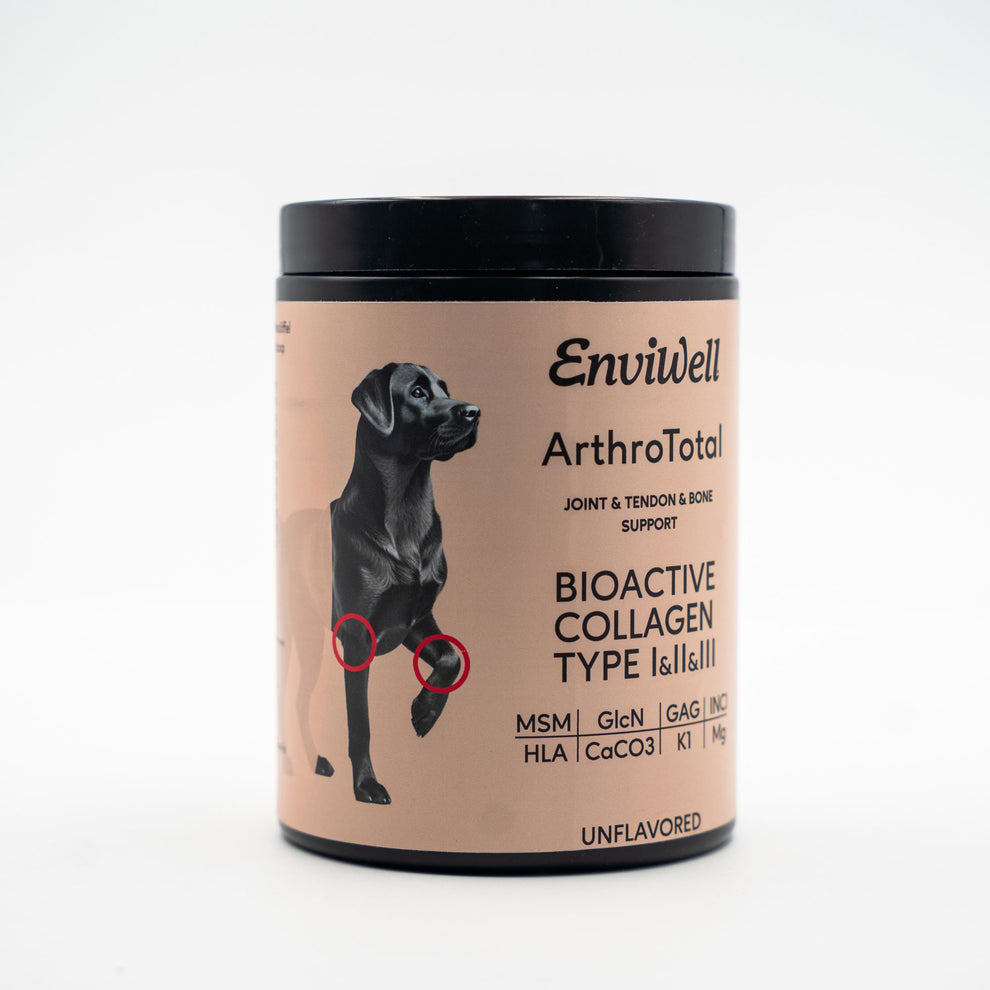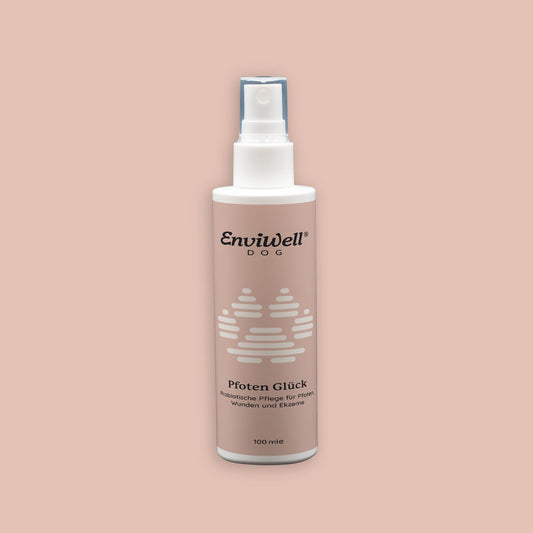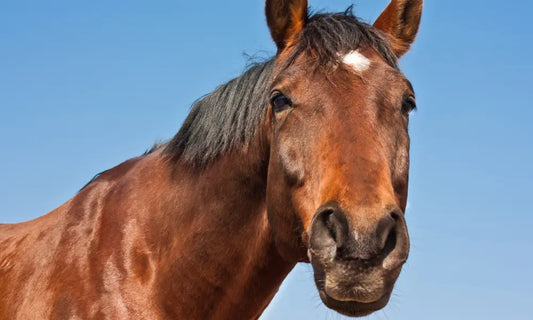
Strengthening dog joints for an active dog life
Alexander DurbanJoints are essential for dogs to move healthily and painlessly – whether walking, playing, or climbing stairs. Unfortunately, joint problems are among the most common ailments in dogs and can significantly impair your four-legged friend's quality of life. The good news is that you can do a lot to protect and strengthen your dog's joints, or to provide targeted relief when needed. Here you'll find everything you need to know about typical joint diseases, their causes, symptoms, and helpful measures for support, treatment, and prevention.
What joint problems are particularly common in dogs?
Joint diseases in dogs often develop gradually and only become apparent late through pain or restricted movement. The most common problems include:
Arthritis: When the joint is chronically inflamed
Arthritis is a persistent inflammation of one or more joints . Affected dogs usually show pain, stiffness (especially in the morning), and reluctance to move. The inflammation often results from wear and tear or as a consequence of another joint disease – such as osteoarthritis – or after injuries. Older dogs are particularly susceptible.
Hip dysplasia: Deformity of the hip joint
Hip dysplasia (HD) is a genetically determined malformation of the hip joint and occurs primarily in large or rapidly growing dog breeds. In this condition, the femoral head and the acetabulum do not fit together properly, leading to instability and, later, cartilage wear. Symptoms often include a "hopping" gait, reluctance to walk, and difficulty getting up.
Osteochondrosis (OCD): Growth disorder in young dogs
Osteochondritis dissecans (OCD) is a developmental disorder of cartilage formation in the joints , particularly in young, rapidly growing dogs of large breeds. The shoulder, elbow, or knee joints are most commonly affected. Affected dogs often limp and avoid putting weight on the affected limb.
Osteoarthritis: Joint wear and tear in an advanced stage
Osteoarthritis is a degenerative joint disease in which cartilage loss leads to pain and restricted mobility. Unlike arthritis, it is not inflammatory – but it can cause inflammation (secondary arthritis). Osteoarthritis usually develops gradually and worsens over time – often in older dogs.

What are the causes of joint problems in dogs?
Various factors can trigger or contribute to joint problems in dogs. The most common causes are:
Genetic predisposition
Many joint diseases, such as hip or elbow dysplasia, are hereditary . Breeding, size, and breed play a significant role. Reputable breeders ensure healthy joint structure in the parent animals and can reduce the risk.
Obesity as a risk factor
Excess weight puts undue strain on the joints, even in healthy dogs. Every extra kilogram can accelerate cartilage degeneration, irritate joints, and promote inflammation. Weight control is therefore a crucial part of prevention.
Aging process and degenerative changes
As dogs age , cartilage loses elasticity and the tissue's ability to regenerate decreases. This increases the risk of osteoarthritis and other degenerative diseases – often earlier in large dogs than in small ones.
Injuries and overuse
Accidents, falls, or repeated overuse of individual joints (e.g., through excessive ball playing or improper training) lead to micro-injuries that can cause long-term damage. Poorly healed injuries can also trigger osteoarthritis.

How can you recognize joint problems in your dog?
Joint problems manifest themselves differently depending on the cause and severity. Pay attention to the following signs in your dog's behavior and movement:
Changes in movement behavior
Many dogs with joint pain exhibit altered movement patterns. These include a stiff gait, limping, lameness, or unsteady gait – especially after periods of rest or intense exercise.
Pain and discomfort
If your dog is reluctant to walk, lies down frequently, or avoids being touched, this could indicate pain. Excessive licking of certain joints or growling when a leg is lifted can also be warning signs.
Restrictions in everyday life
Many dogs with joint problems find it difficult to climb stairs, get up, jump, or play. They become more withdrawn, seem less lively, or sleep an unusual amount.
What can you do to strengthen your dog's joints?
Prevention is often the best protection – especially in cases of genetic predisposition or in older dogs. The following measures will help you actively promote joint health.
Joint-friendly movement is key.
Regular exercise, adapted to your dog's age and condition, is crucial. Ideally, this should consist of consistent activity such as:
- Swimming or underwater treadmill
- Walks on soft ground
- Light trick training or cavaletti work
Avoid jumping, abrupt stops (e.g. when throwing a Frisbee) and overexertion.
Weight control provides long-term protection
A lean dog is healthier – especially for its bones and joints. Maintain a healthy weight and avoid overfeeding. If in doubt, have your vet assess your dog's Body Condition Score (BCS).
Tailoring nutrition specifically to joint health
The right food not only provides energy, but can also support the formation and regeneration of cartilage.
Which foods support joints?
Food containing omega-3 fatty acids (e.g., from fish oil), antioxidants, manganese, or green-lipped mussel extract can inhibit inflammation and protect joint structures. Ensure a protein-rich, balanced diet without unnecessary fillers.
Supplementary feed: When do they make sense?
Dogs at increased risk for joint problems often benefit from supplements, such as:
- Glucosamine and chondroitin sulfate : promote cartilage formation
- MSM (methylsulfonylmethane) : has anti-inflammatory properties
- Hyaluronic acid : improves joint fluid
These substances are often found in joint powders such as ArthroTotal Dog from EnviWell .
Collagen as an important component of healthy joints
Collagen is particularly valuable for joint health. As the main component of cartilage, tendons, and ligaments, it is essential for their stability and elasticity. A product like ArthroTotal – Collagen Powder for Dogs addresses this need directly. It combines bioactive, hydrolyzed collagen (types I, II & III) with other important joint nutrients such as glucosamine, chondroitin, MSM, and hyaluronic acid. This comprehensive formula not only supports the regeneration of joint structures but also promotes mobility and your dog's overall quality of life. The included inulin (a prebiotic fiber) further supports a healthy gut flora, which improves nutrient absorption.
Typical ingredients and their effects
- Glucosamine : a component of joint cartilage, supports regeneration
- Chondroitin : inhibits cartilage-degrading enzymes
- MSM : can alleviate inflammation at the cellular level
- Hyaluronic acid : improves joint lubrication
Application recommendations
Joint powder for dogs can easily be mixed into their food. However, pay attention to the dosage according to the manufacturer's instructions and discuss long-term use with your veterinarian.
The recommended daily dose of ArthroTotal from EnviWell for a dog weighing 50 kg is 10g (1 scoop) once a day. This ensures a targeted and effective supply of valuable nutrients.

What treatment options are available for joint problems?
If your dog already has joint problems, there are different approaches. Often, a combination of several measures makes the biggest difference.
Painkillers and anti-inflammatory drugs
Veterinarians often prescribe NSAIDs Non-steroidal anti-inflammatory drugs (NSAIDs) such as carprofen or meloxicam are used to relieve pain and inflammation. These are effective, but long-term use can have side effects on the liver, stomach, or kidneys – therefore, medical supervision is important.
Natural and alternative therapies
Herbal supplements such as devil's claw or frankincense are increasingly used as supportive treatment. Acupuncture, laser therapy, or leeches are also used successfully in some dogs – however, the benefits should always be discussed with a veterinarian.
Physiotherapy and targeted exercise promotion
Physiotherapy can help build muscle, reduce pain, and maintain joint mobility. Typical methods include:
- Movement exercises
- Underwater treadmill
- Massages or manual therapy
Nutrition and special feed support the treatment
For dogs with osteoarthritis, there are special diets that already contain joint-supporting ingredients. These also help with weight management. A targeted change in diet can be part of the therapy.

How can you prevent joint problems?
Many joint diseases cannot be completely ruled out – but you can reduce the risks.
Early prevention is crucial
Proper growth is important even in puppyhood. Don't let large dogs grow too quickly (provide appropriate food) and avoid overexertion during their youth.
Regular veterinary check-ups are carried out.
Regular check-ups (especially in old age or with a genetic predisposition) help to detect abnormalities early – before they worsen.
Your everyday life makes the difference
- Ensure non-slip floors
- Avoid frequent stair climbing.
- Adjust the activity level to your dog's age.
- Feed appropriately and according to weight.
What you should remember: Joints need active care.
Your dog's joint health isn't a matter of chance. With knowledge, attention, and targeted measures, you can make a big difference – both in prevention and in managing existing problems. This includes healthy exercise, a suitable diet, regular checkups, and, if necessary, supplements like joint powder. Pay attention to early warning signs and, if in doubt, consult your veterinarian early – because the sooner you act, the better your dog's quality of life can be.
Frequently Asked Questions and Answers
1. What joint problems are common in dogs?
The most common include arthritis, hip dysplasia, elbow dysplasia, and osteoarthritis. They can cause pain and restricted mobility.
2. How can I strengthen my dog's joints?
Encourage joint-friendly exercise like swimming, monitor weight, and provide high-quality food. Supplements such as glucosamine or omega-3 fatty acids can offer additional support.
3. What are the symptoms of joint problems in dogs?
Typical signs include lameness, stiffness, difficulty starting, avoidance of certain movements, reluctance or pain when getting up and walking.
4. What role do joint powders play in dogs?
They can support the formation and regeneration of joint cartilage and counteract inflammation – especially in older or stressed dogs.
5. How can I treat arthritis in my dog?
Treatment usually consists of anti-inflammatory medication, physiotherapy, and nutritional supplements. Early intervention is crucial.
6. What should I consider regarding my dog's diet to support their joints?
Food should contain omega-3 fatty acids, antioxidants, and, if necessary, joint-supporting supplements. Ensure a balanced, calorie-appropriate diet.






